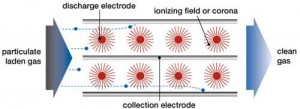An electrostatic precipitator (ESP), or electrostatic air cleaner is a particulate collection device that removes particles from a flowing gas (such as air) using the force of an induced electrostatic charge. Electrostatic precipitators are highly efficient filtration devices that minimally impede the flow of gases through the device, and can easily remove fine particulate matter such as dust and smoke from the air stream.

The most basic precipitator contains a row of thin vertical wires, and followed by a stack of large flat metal plates oriented vertically, with the plates typically spaced about 1 cm to 18 cm apart, depending on the application. The air or gas stream flows horizontally through the spaces between the wires, and then passes through the stack of plates.
A negative voltage of several thousand volts is applied between wire and plate. If the applied voltage is high enough an electric (corona) discharge ionizes the gas around the electrodes. Negative ions flow to the plates and charge the gas-flow particles.
The ionized particles, following the negative electric field created by the power supply, move to the grounded plates.
Particles build up on the collection plates and form a layer. The layer does not collapse, thanks to electrostatic pressure (given from layer resistivity, electric field, and current flowing in the collected layer).
Precipitator performance is very sensitive due to two particulate properties: 1) Resistivity; and 2) Particle size distribution. These properties can be determined economically and accurately in the laboratory. A widely taught concept to calculate the collection efficiency is the Deutsch model, which assumes infinite remixing of the particles perpendicular to the gas stream.
Advantages:
1. Low Installation cost
2. High efficient process to control air pollution
3. Less Pollution

